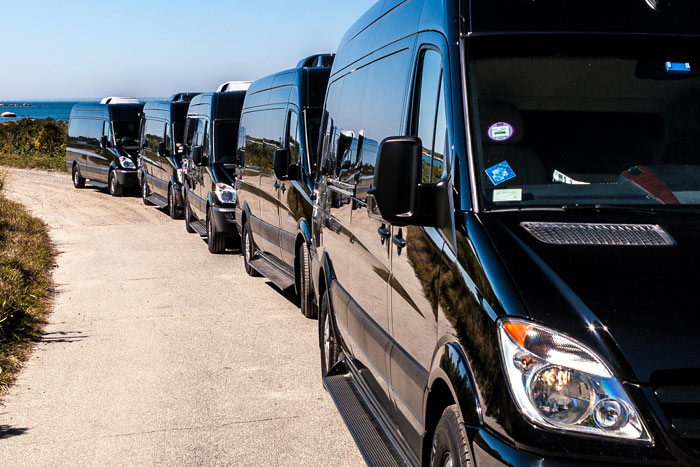20 Free Facts For Picking Employee Shuttle Websites
20 Free Facts For Picking Employee Shuttle Websites
Blog Article
Top 10 Tips To Choose The Right Vehicle And Capacity For Employee Shuttle Transportation
Here are 10 tips for selecting the right vehicle and capacity to provide employee shuttle services:
1. Think about the needs of your employees for transportation.
In the beginning do a thorough study of your staff to determine the number of them use the shuttle regularly. Take into consideration factors like the size of the employees, work shifts, and peak usage times. This information will assist you in selecting the right vehicle capacity and ensure that the shuttles have the ability to accommodate a range of passengers.
2. Select the right vehicle type
Choose the vehicle that is the best fit for your shuttle service based on the number of employees you employ and what their needs are. Minibuses are readily available, along with vans and larger buses. Minibuses are ideal for smaller parties and are able to maneuver through tighter spaces, whereas larger buses are ideal for high-capacity needs. Be aware of the design and whether it provides comfortable seating and sufficient space for luggage, especially if employees are traveling with bags or other equipment.
3. Evaluate Fuel Efficiency
Costs for fuel have a huge influence on the budget of shuttle services. Make sure to select vehicles that have lower fuel consumption to help reduce expenses. Electric or hybrid vehicles are also worth considering as they offer the potential for long-term savings, while also aligning with sustainability goals. An analysis of fuel efficiency could help you make an informed decision about your purchase by balancing costs and capacity.
4. Consider Accessibility Features
Check that the vehicle you select is compliant with accessibility standards to accommodate people with disabilities. This could include features like the wheelchair lift or low floor that makes accessible, and seating reserved for those with mobility challenges. Accessible transportation isn't just legally required, but it also promotes an environment that is more inclusive.
5. Plan for Growth & Flexibility
The size of the workforce could alter as companies grow. When deciding on the best vehicles for your company it is important to consider the possibility of the future growth of your business. In investing in vehicles that have seats that can be adjusted or with the option to expand capacity will give you the flexibility necessary to adapt to the changing needs of employees without the need for frequent replacements of vehicles.
6. Learn more about safety features and ratings
Transportation for employees must be secure. Before selecting a vehicle be sure to check its safety ratings and features. Consider vehicles that are equipped with the latest safety technology including stability control, anti-lock brakes and collision avoidance systems. Additionally, ensure that the vehicles meet the federal and local safety standards to safeguard employees while they travel.
7. Evaluation of Maintenance and Reliability
Choose vehicles with low maintenance and high reliability. A vehicle that frequently requires repairs could disrupt shuttle operations and lead to employee dissatisfaction. Also, you can develop a maintenance schedule to keep vehicles in top conditions and extend their lifespan.
8. GPS and Fleet Management Software
Implementing GPS tracking software and managing fleets can improve the efficiency of shuttle services. These software tools allow real-time tracking of vehicles, allowing for optimal routes to be determined in accordance with the weather conditions or schedules of employees. The use of fleet management also allows for monitoring vehicle usage, maintenance and consumption of fuel to ensure that vehicles are being used effectively.
9. Implementing Feedback Mechanisms for Employees
Encourage employees to provide feedback via surveys or suggestion box on the quality and comfort of the vehicles. Understanding their experience will help you identify issues with overcrowding as well as accessibility or seating issues. Regularly reviewing this feedback will facilitate necessary adjustments to vehicle selection or service adjustments to ensure a positive transport experience.
10. Total cost of ownership: Budgeting for the entire cost
When choosing a vehicle, take into consideration the total cost of ownership (TCO), which includes purchase price, fuel costs, maintenance, insurance, and depreciation. TCO analysis aids in making an informed decision that balances initial investment with long-term operational expenses. When you evaluate all expenses associated with a car and your company will be able to select one that is within budgetary limitations and offers the necessary capacity and reliability.
Use these guidelines to ensure that your organization is able select the appropriate vehicle and control the number of shuttles for employees. Have a look at the most popular employee shuttle blog for site advice including car service pick up, airport shuttle service near me, airport service, airport bus shuttle, transportation to airport, top transportation, pick up service airport, car service to and from airport, ground transportation, airport shuttle service and more.
Top 10 Tips For Safety And Reliability Of The Transportation Service For Corporate Events
Here are 10 tips regarding safety and reliability an event transport service for corporate events:
1. Conduct thorough inspections of your vehicle
Before an event, be sure all vehicles have been thoroughly inspected. Check all important components for the proper operation including brakes. Tires. Lighting. Seatbelts. Regular maintenance, and pre-trip inspections, can minimize the possibility of mechanical breakdowns.
2. Hire experienced and qualified drivers
Verify that the drivers have clean driving records and are licensed and certified. Background checks should be conducted and their previous experience in the transportation of corporate events, in particular confirmed. Drivers who have experience and are well-trained will ensure that transportation is secure and reliable.
3. Safety Training Programs
Train all drivers and staff to be safe. Training should concentrate on defensive driving skills, emergency procedures, customer service, and emergency procedures. Regularly scheduled training sessions ensure that safety is always in the forefront and prepare drivers to handle different situations that could occur.
4. Establish Clear Emergency Protocols
Develop and communicate an emergency plan that is clear for drivers and passengers. This covers procedures for accidents, medical emergencies, and other emergencies that might arise. Conduct drills to ensure everyone is aware of how to respond efficiently in the event of an emergency, enhancing overall security.
5. GPS Tracking Software and Fleet Management Software
Use GPS tracking of all vehicles in order to track the exact location of each vehicle at any time. With this technology, transportation coordinators are able to monitor shuttles in real time as well as optimize routes and react quickly to any potential issues. Fleet management software can assist in monitoring vehicle performance and maintain the vehicle.
6. Ensure Adequate Insurance Protection
Make sure you have a complete insurance policy for all transport operations. It should cover liability and accidents that may occur on the roads. A well-constructed insurance policy will safeguard your company as well as the participants. It gives peace of peace of.
7. Send clear messages to the attendees
Communication of transportation details is crucial. Include times, pickup locations as well as the contact details of the transportation coordinators. This helps attendees to feel at ease and manage their expectations by providing the information beforehand.
8. Check weather conditions and traffic patterns
Be aware of the weather and traffic conditions during the day. Make sure you are prepared to modify routes or schedules as needed to ensure that you arrive on time. Transportation services are more reliable if they have a plan for dealing with adverse weather conditions or traffic.
9. Review Event Feedback and Post-Event Reviews.
When the event has ended You should gather feedback from attendees on their experience with transportation. Request feedback regarding safety, timeliness and overall satisfaction. Reviewing this feedback can identify areas of improvement and ensure that future transportation services comply with safety and reliability requirements.
10. Create a Contingency Plan
Prepare a contingency strategy for unexpected events, such as vehicle failures or absenteeism of drivers. The plan should include alternate transport options, as well as procedures to be followed in the situation of an emergency. The contingency plans will increase the reliability of your event, so that attendees will not be left stranded.
With these suggestions businesses can increase the security and reliability of their transportation services for corporate clients. The importance of ensuring the safety of guests is not only beneficial to them but also for the company. A reliable transportation service is essential for the overall success of corporate events. It makes sure that guests are provided with a seamless event experience. See the recommended www.swoopapp.com/solutions/event-transportation-service transport for more recommendations including pace transportation, trailering services, transporting buses, transport comp, group transport, transport manager job, transport logistics company, transportation services, us transport, transportation management and more.